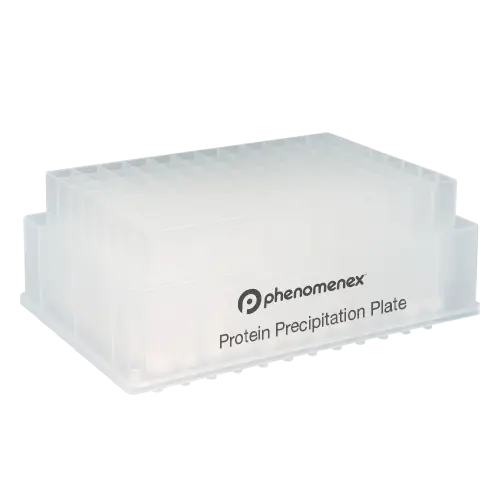
Protein Precipitation (PPT)
What is Protein Precipitation?
Proteins in biological sample matrices have a dramatic effect in HPLC/UHPLC column lifetime and can interfere with MS detector sensitivity. Protein precipitation is a simple sample preparation technique that is used to remove proteins from the sample using an organic solvent or a salt.
Although there are several methods for precipitating proteins from plasma and tissue, very few offer reproducible and effective removal of proteins from sample without excessive sample transfer, which can result in loss of recovery of the target analyte.
The ideal protein precipitation method allows for consistent protein removal with as few sample transfers as possible.
Different Methods of Protein Precipitation Extraction
When sample preparation involves protein precipitation, a single technique is usually used. Here are the different protein precipitation methods:
- Acid Precipitation: This method extracts proteins through precipitation by reducing the solution's pH to their isoelectric point (pI), causing them to lose charge and precipitate. Trichloroacetic acid (TCA) is commonly used for its high reactivity and efficiency, but it denatures proteins, making them non-functional.
- Salting Out (Salt Precipitation): High salt concentrations (e.g., ammonium sulfate, zinc sulfate) reduce water availability for protein hydration, causing precipitation and aggregation. This method is mild, allowing proteins to retain their biological function after re-solubilization.
- Organic Solvent Precipitation (Alcohol Precipitation): Solvents like ethanol, methanol, and acetone disrupt protein hydration, leading to aggregation and precipitation. Performing the process at low temperatures helps preserve protein integrity.
- Chloroform/Methanol Precipitation: A highly effective technique for isolating proteins while minimizing loss, using chloroform and methanol to separate proteins from other cellular components.
- Polyethyleneimine (PEI) Precipitation: PEI, a cationic polymer, binds negatively charged proteins, forming insoluble complexes that facilitate protein precipitation.
Featured Product for Protein Precipitation

Protein Precipitation Documents
Protein Precipitation Documents
| Type | Document Title |
|---|---|
| Brochures | Sample Preparation Accessories |
| Poster | Sample Preparation Overview Poster |
| Brochures | Presston 1000 Positive Pressure Manifold |
| Brochures | Sample Preparation Made Simple Overview |
| Brochures | Presston 1000 Positive Pressure Manifold |
| Guide | Solid Phase Extraction for Clinical Research |
| Brochures | Pharmaceutical Analysis Guide, Volume 1 - Bioanalytical |
| Brochures | An Easier Solution for Protein Precipitation |
| Guide | Sample Preparation Reference Manual & Users Guide |
| Supporting Docs | PhenoAcademy - The MOST LOVED Educational Webinar Series |












